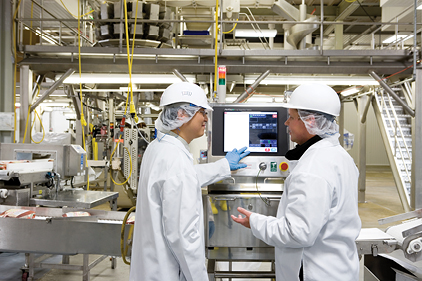For meat and poultry processors, metal detectors and X-ray inspection systems are employed to identify foreign objects in their products in much the same way. These food-safety tools are helping meat and poultry processors reliably remove more foreign objects from their processing materials.
Metal detection and X-ray technology are being used more than ever, says Donna Schaffner, associate director of food safety, quality assurance and training at Rutgers Food Innovation Center, Bridgeton, N.J. These detection technologies have become critical to processors’ food-safety initiatives.
“A large number of companies have X-ray and metal-detection equipment as a critical control point,” she explains. “The way they have written their
HACCP plans — their food-safety plans — they have to do that. They cannot release their product without putting it through the metal detection or through the X-ray machine, so it’s absolutely essential.”
Many meat and poultry processors use metal-detection and X-ray technology to check their final product before it is ready to ship, Schaffner says. Some companies also use detection technology for checking raw materials.
“If a processor brings in a chopped meat that they are going to use in something else, sometimes they will metal-detect just the meat as it comes in as a raw material before they put it into their process,” Schaffner explains. “That way, if they find any metal, that protects their equipment. They are typically metal-detecting their final product also, but at that point, they’ve already put the meat together with the other ingredients, cooked it and packaged it. So if you only checked it at the end of the line, you’d lose everything and not just the meat.”
Advancing food safety with X-ray
OSI Group LLC, Aurora, Ill., has worked closely with X-ray suppliers to improve the application of X-ray technology and integrate it into its processing systems globally. In a short amount of time, the company has been able to improve product quality significantly, leading to a marked increase in customer satisfaction, the company says.
Justin Ransom, OSI Group’s assistant vice president of food protection and government affairs, says several factors contributed to the success of X-ray implementation. The company first worked with technology providers to present the product to them in a manner providers could X-ray and then remove the affected product out of the stream.
“So in taking a more holistic approach, we’ve tested X-ray application in different food matrices from raw material to preformed to finished product,” Ransom explains. “Understanding the challenges of each of those different matrices and how we reject foreign objects in our process has been critical to being able to get this technology going for us at the line speeds at which we operate.”
OSI Group began putting X-ray technology into its processing systems about five years ago.
“Basically once we began to understand where the best places to use X-ray were, we began putting it in processes all over the world, whether it be for some sort of patty, or a liquid product, or like beans and salsas,” Ransom says. “Each one of these different food matrices has a different algorithm that is used to detect foreign bodies. We just had to get into the process where we understand the risks, and work with the technology providers in making sure that we have the settings appropriate for the product that we are X-raying.”
The ease of implementing X-ray technology depended on the product being processed. For example, for finished product patties, incorporation of X-ray technology has been fast, Ransom says.
“It’s been relatively easy because the product is all the same size, the same shape and the same height, and that was relatively easy to implement there,” he explains. “The challenge has now become, how do we reject less product?
“We only reject the product that has a problem rather than rejecting multiple patties at one time or multiple products at one time,” he continues. “That’s how we’re taking it to the next level.”
Another challenge OSI Group currently is undertaking is how to X-ray its raw materials.
“The best place to put an inspection system, in our opinion, as we continue to be committed to quality in food safety in all of our processes, is at the beginning of the process so that we’re not inspecting quality into it, but that we’re detecting foreign objects before they ever enter our process,” Ransom says. “That’s what we really have spent the last 18 months on, working with different technology companies trying to help us identify a solution for raw-material inspection before it goes through our grinding process.”
“It’s more of a whole systems approach that we are taking to identify and remove foreign objects from our process,” Ransom says. “That’s why working on the raw material is so critical and important to us.”
While OSI Group continues to make progress in using X-ray technology in its food-safety strategies, the success of its currently executed X-ray detection systems has paid off already.
“We’ve seen a significant improvement in reduction in total complaints, specifically bone complaints. In the U.S., we’ve also continued to improve, and with less sensitive customers, we have seen the same improvement in both our domestic and export markets,” Ransom says.
Moving detection forward
X-ray has become a much more effective tool for processors since the technology has advanced to meet production demands. Ransom says that computers can run algorithms, identify a foreign object and remove it from the process to match today’s faster operating speeds. In addition to removing foreign objects from the processing system, X-ray has become an interesting tool for OSI Group because computers can analyze the data that’s generated by the X-ray system.
“As data processing becomes faster and faster, I think we’re going to see increased ability from these detection systems to identify foreign objects throughout the process,” Ransom says. “Currently, they can do it. They just have to keep up with our line speeds [to allow us] to operate our systems efficiently.”
While X-ray and metal-detection systems offer many viable detection solutions for processors, the detection field continues to grow. Plastics and materials that float continue to be a detectable challenge for processors. Non-metallic objects, especially brittle plastics, ceramic glass, wood splinters, also are a detection challenge for most processors, Schaffner says.
“There are lots of other foreign materials that might get into a product — especially non-metal equipment parts — that could end up in a product that a metal detector cannot find,” she says. “X-ray is better at finding them, but even X-ray is not good with small splinters of glass, and some of the plastics just don’t show up well unless a company buys the metal detectable products.”
More companies now are using barium-impregnated plastics for tools and small parts that were not detectable before as straight plastics, Schaffner says. The impregnated plastics can be found if lost in a product with the use of metal detectors or X-ray technology, she explains.
“These materials are effective,” Schaffner says. “They are just expensive. Companies have to weigh the risk versus the cost, because it’s much more expensive to buy these products than the traditional ones.”
False positives, particularly if a company works with frozen products with ice buildup, are another detection challenge many companies face. Location of the detection equipment in relation to other pieces of equipment also could cause electrical surges, which sometimes generate false positives, Schaffner says.
“A big problem I see occurs when employees get used to false positives and [don’t pay] attention when there might be an actual problem,” she says, adding that accuracy is improving, however, as detection technology advances. Schaffner, who works with many small to medium-sized processors across the food industry, says that putting in X-ray equipment also is quite a large expenditure.
“To go from just the simple metal detection to an X-ray machine is a big step for a lot of companies,” she says. Making the use of metal-detection and X-ray technology a priority also can be a challenge for some processors, Schaffner adds.
“In the past, some companies have considered it non-essential, and now the way that food-safety concerns are growing, with much more emphasis on HACCP, I think that a lot more companies are being forced to metal-detect the finished product where in the past they didn’t,” she says. “I just see a much more wide use of it than it has been in the past.”





Report Abusive Comment